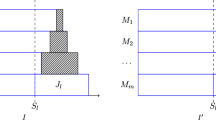Abstract
We revisit randomized smoothing networks (Herlihy and Tirthapura in J Parallel Distrib Comput 66(5):626–632, 2006), which are made up of balancers and wires. We assume that balancers are oriented independently and uniformly at random. Tokens arrive arbitrarily on w input wires and propagate asynchronously through the network; each token is served on the output wire it arrives at. The smoothness is the maximum discrepancy among the numbers of tokens arriving at the w output wires. We present a collection of lower and upper bounds on smoothness, which are to some extent surprising: (1) The smoothness of a single block network is lg lg w+Θ(1) (with high probability), where the additive constant is between −2 and 3. This tight bound improves vastly over the upper bound of \({\mathcal{O}(\sqrt{lg\, w})}\) from Herlihy and Tirthapura (2006), and it essentially settles our understanding of the smoothing properties of the block network. Further, this lg lg w+Θ(1) bound cannot be extended to universal smoothing a property stronger than smoothing that we introduce. (2) Most significantly, the smoothness of the cascade of two block networks is no more than 17 (with high probability); this is the first known randomized network with so small depth (2 lg w) and so good (constant) smoothness. The proof introduces some combinatorial and probabilistic structures and techniques which may be further applicable; the result demonstrates the full power of randomization in smoothing networks. (3) There is no randomized 1-smoothing network of width w and depth d that achieves 1-smoothness with probability better than \({\frac{\mathsf{d}} {w-1} }\) . In view of the deterministic, Θ(lg w)-depth, 1-smoothing network in Klugerman and Plaxton (Proceedings of the 24th Annual ACM Symposium on Theory of Computing, 1992), this result implies the first separation between deterministic and randomized smoothing networks. These results demonstrate an unexpected limitation on the power of randomization for smoothing networks: although it yields constant smoothness using small depth, going down to smoothness of 1 requires linear depth.
Similar content being viewed by others
References
Aharonson E., Attiya H.: Counting networks with arbitrary fan-out. Distrib. Comput. 8(4), 163–169 (1995)
Aiello, W., Venkatesan, R., Yung, M.: Coins, weights and contention in balancing networks. In: Proceedings of the 13th Annual ACM Symposium on Principles of Distributed Computing, pp. 193–205 (1994)
Ajtai M., Komlós J., Szemerédi E.: Sorting in c lg n Parallel Steps. Combinatorica 3(1), 1–19 (1983)
Alon N., Spencer J.: The Probabilistic Method, Wiley-Interscience Series in Discrete Mathematics and Optimization, 2nd edn. Wiley, NY (2000)
Aspnes J., Herlihy M., Shavit N.: Counting networks. J. ACM 41(5), 1020–1048 (1994)
Batcher, K.E.: Sorting networks and their applications. In: Proceedings of the AFIPS Joint Computer Conference, pp. 334–338 (1968)
Bertsekas D.P., Tsitsiklis J.N.: Parallel and Distributed Computation: Numerical Methods. Athena Scientific, Nashua (1997)
Busch, C., Mavronicolas, M.: An efficient counting network. In: Proceedings of the 1st Merged International Parallel Processing Symposium and IEEE Symposium on Parallel and Distributed Processing, pp. 380–384 (1998)
Dowd M., Perl Y., Rudoplh L., Saks M.: The periodic balanced sorting network. J. ACM 36(4), 738–757 (1989)
Dwork C., Herlihy M., Waarts O.: Contention in shared memory algorithms. J. ACM 44(6), 779–805 (1997)
Fristedt B., Gray L.: A Modern Approach to Probability Theory, Probability and Its Applications. Birkhäuser, Basel (1997)
Herlihy M., Shavit N.: The Art of Multiprocessor Programming. Morgan Kaufmann/Elsevier, San Francisco/Amsterdam (2008)
Herlihy M., Tirthapura S.: Randomized smoothing networks. J. Parallel Distrib. Comput. 66(5), 626–632 (2006)
Herlihy M., Tirthapura S.: Self-stabilizing smoothing and counting networks. Distrib. Comput. 18(5), 345–357 (2006)
Hoeffding W.: Probability inequalities for sums of bounded random variables. J. Am. Stat. Assoc. 53, 13–30 (1963)
Kapidakis, S., Mavronicolas, M.: Distributed, low contention task allocation. In: Proceedings of the 8th IEEE Symposium on Parallel and Distributed Processing, pp. 358–365 (1996)
Klugerman, M.: Small-Depth Counting Networks and Related Topics, Ph.D. Thesis, Department of Mathematics, Massachusetts Institute of Technology (1994)
Klugerman, M., Plaxton, C.G.: Small-Depth Counting Networks. Proceedings of the 24th Annual ACM Symposium on Theory of Computing, pp. 417–428 (1992)
Knuth, D.E.: The Art of Computer Programming, vol. 3/Sorting and Searching, 2nd edn. Addison-Wesley, Reading (1998)
Kruskal C.P., Snir M.: A unified theory of interconnection network structure. Theor. Comput. Sci. 48(3), 75–94 (1986)
Mavronicolas, M., Sauerwald, T.: A randomized, O(lg w)-depth 2-smoothing network. In: Proceedings of the 21st Annual ACM Symposium on Parallelism in Algorithms and Architectures, pp. 178–187 (2009)
Preparata F., Vuillemin J.: The cube-connected-cycles: a versatile network for parallel computation. Commun. ACM 24(5), 300–309 (1981)
Riedel, M.D., Bruck, J.: Tolerating Faults in Counting Networks, Technical Report ETR-22, Paradise, California Institute of Technology (1999)
Author information
Authors and Affiliations
Corresponding author
Additional information
A preliminary version of this work appeared in the Proceedings of the 27th Annual ACM Symposium on Principles of Distributed Computing, pp. 345–354, August 2008. This work has been partially supported by the IST Program of the European Union under contract number 15964 (AEOLUS) and by the German Science Foundation (DFG) Research Training Group GK-693 of the Paderborn Institute for Scientific Computation (PaSCo).
Part of the work of M. Mavronicolas was done while visiting the Faculty of Computer Science, Electrical Engineering and Mathematics, University of Paderborn.
Part of the work of T. Sauerwald was done while being with the Faculty of Computer Science, Electrical Engineering and Mathematics, University of Paderborn, and while visiting the Department of Computer Science, University of Cyprus.
Rights and permissions
About this article
Cite this article
Mavronicolas, M., Sauerwald, T. The impact of randomization in smoothing networks. Distrib. Comput. 22, 381–411 (2010). https://doi.org/10.1007/s00446-009-0087-3
Received:
Accepted:
Published:
Issue Date:
DOI: https://doi.org/10.1007/s00446-009-0087-3




